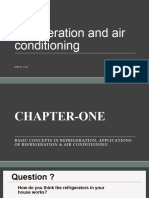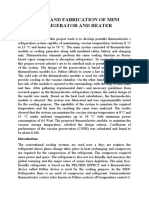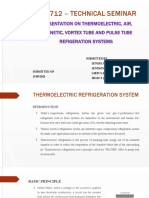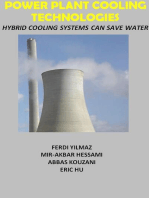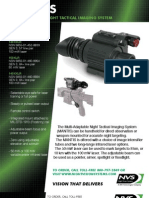Space Borne Cooling Systems
Space Borne Cooling Systems
Uploaded by
GAURAV SINGHCopyright:
Available Formats
Space Borne Cooling Systems
Space Borne Cooling Systems
Uploaded by
GAURAV SINGHOriginal Description:
Copyright
Available Formats
Share this document
Did you find this document useful?
Is this content inappropriate?
Copyright:
Available Formats
Space Borne Cooling Systems
Space Borne Cooling Systems
Uploaded by
GAURAV SINGHCopyright:
Available Formats
Assignment
Heat Transfer in Space Applications
By-Gaurav
Space borne Cooling Systems
Some spacecraft payloads require cooling to low temperatures.
The most common types of cooled instruments include IR-sensor
focal planes and optics, as well as Low-noise amplifiers for RF
receivers.
Several devices are available for cooling such applications, including
radiators, stored-cryogen cooling systems, and refrigerators.
The Defense Support Program (DSP) satellite uses a system of
radiators to cool the optics and focal plane.
Parts in DSP sensor
1. Thermoelectric coolers
2. Helium circulators
3. Phase Change Materials (PCM) canisters
4. Forward facing radiators (FFR)
5. TCS electronics unit and power supply
Concept Helium circulator transports focal plane/PCM heat to nonsolar
illuminated forward-facing radiator (FFR)
Circulator turned off when FFR solar illuminated-focal plane heat
melts PCM
PCM is refrozen when circulator resumed refrozen when circulator
resumed
Working: The optical elements (mirrors) and the telescope enclosure and
baffles are cooled passively by covering the telescope enclosure
with low-absorptance, high-emittance quartz mirrors.
Cooling the optics and enclosure reduces the amount of IR
radiation emitted from those surfaces.
Assignment
Heat Transfer in Space Applications
By-Gaurav
Without this cooling, the sensors at the focal plane would not be
able to see their targets over the IR "noise" created by the telescope
itself.
The focal-plane assembly is connected to a phase-change-material
(PCM) heat sink and a passive radiator by a pumped-helium loop.
The operating principle of this system is the transporting of heat
from the focal plane and PCM to the radiator by means of a
pumped-helium loop during the half of the orbit when the sun does
not shine on the radiator. During the other half-orbit, solar
illumination heats the radiator to temperatures well above those of
the focal plane.
To avoid a focal plane temperature rise, the helium circulation is
shut off, effectively decoupling the radiators, and the heat loads
from the focal plane are stored in the PCM.
When the sun moves behind the vehicle, the circulator is turned
back on to reject the focal-plane heat and the excess heat stored in
the PCM.
Minimizing heat leaks into the forward-facing radiator by the use
of MLI and low-conductance supports on the back side is critical
to achieving low-temperature performance.
Even small heat leaks into the radiator during the shadowed halforbit can raise its temperature considerably from 173 K. (Because
of the T 4 nature of radiation-heat transfer, only one-fifth as much
heat is needed to raise radiator equilibrium temperatures one
degree at 173 K than at room temperature.)
For lower-temperature radiators the sensitivity is even greater; for
example, the sensitivity is greater by a factor of 50 at 80 K than at
room temperature. For this reason, low-temperature radiators are
extremely sensitive to heat loads from the environment or heat
leaks from the spacecraft.)
Assignment
Heat Transfer in Space Applications
By-Gaurav
Devices requiring cooling to very low temperatures and having
limited lifetime requirements (less than 1 or 2 years) usually employ
stored-cryogen cooling systems. Designs for such devices use a
cryogenic fluid or solid stored in a debar as a heat sink to absorb
waste heat from the device and maintain it at a low temperature. An
example of such a system is the Infrared Astronomical Satellite
(IRAS). The cryogen in this case is 70 kg of helium stored at 1.85 K
in a tank that is wrapped around the satellite's telescope assembly.
Spacecraft Cryogenic Cooling
The HgCdTe detector arrays are required to be cooled to 80K during
operation. A number of methods for producing cryogenic temperatures
in spacecraft have been used in the past and were considered for CIRS
(composite infrared spectrometer).
1. Stored Cryogens
The simplest way of attaining cryogenic temperatures on a spacecraft is
to carry a dewar of a cryogenic material in either liquid or solid form.
The detectors to be cooled would then be mounted on the wall of the
dewar to use the cryogen as a heat sink. Suitable cryogens could be for
example solid argon or liquid helium. The temperature at which the
cryogen boils or sublimes is varied by throttling the exhaust valve to
vary the pressure above the cryogen.
This method of cooling was used successfully by the CLAES
instrument on the UARS spacecraft. Stored cryogen coolers are
unsuitable for use on the Cassini mission because of the extremely long
mission duration - CLAES was a heavy, earth orbiting instrument which
still had only an 18 month lifetime so making a stored cryogen system
which would weigh only 2.5kg (the mass of the CIRS cooler) and which
would have sufficient life time for the Cassini mission would be
impractical.
Assignment
Heat Transfer in Space Applications
By-Gaurav
2. Mechanical Coolers
A number of mechanical coolers have been flown to produce 80K
temperatures on space borne instruments for example the ISAMS
instrument on UARS used two Stirling cycle coolers producing
approximately 800mW of cooling at 80K. They consumed
approximately SOW of electrical power and weighed over 4kg. This
level of cooling is considerably more than the 200mW total cooling
power needed for the CIRS 80K stage.
The mechanical coolers currently available commercially have
an operating lifetime which is too short for use on Cassini, and would
create vibration problems on CIRS. A large amount of development
work would therefore be required to reduce the power requirement and
increase the operating life time to levels usable in the outer solar system.
3. Radiative Coolers
Radiative coolers are simple passive cooling devices. The principle of
operation is that a high emissivity radiator is directed towards space
which has an effective temperature of approximately 4K and an
emissivity of unity.
For deep space missions radiative coolers have a number of
advantages over the other types of coolers discussed for cooling
detectors: They require no electrical power to provide cooling. This is
especially important in the outer solar system where solar arrays
are not usable so the electrical power must be provided by thermal
generators (RTG's).
There are no moving parts, giving an effectively unlimited
lifetime. The main limitation is the degradation of the surfaces due
to contamination or radiation.
Their mass is significantly lower than an equivalent stored cryogen
cooling system.
You might also like
- Refrigeration 3Document36 pagesRefrigeration 3May Jade Genzola EsparesNo ratings yet
- Tank T-90Document27 pagesTank T-90imcoolsha999100% (2)
- On The Compressor and Condenser Units Are Discussed. Cryogenic Temperatures AreDocument12 pagesOn The Compressor and Condenser Units Are Discussed. Cryogenic Temperatures AreArjun Radhakrishnan100% (1)
- Ch3 RefrigerationDocument20 pagesCh3 Refrigerationchams alacilNo ratings yet
- R&ACDocument66 pagesR&AC19-309 Khaleel ur RahmanNo ratings yet
- Cryogenic Solutions For IR DetectorDocument7 pagesCryogenic Solutions For IR DetectortiencanhtrangianNo ratings yet
- Magnetic Refrigeration SeminarDocument8 pagesMagnetic Refrigeration SeminarKEYUR100% (7)
- Magnetic Refrigeration AssignmentDocument8 pagesMagnetic Refrigeration AssignmentAwais Asghar KhanNo ratings yet
- Introduction To Closed Cycle Cooling Systems (For MICE) : Tom Bradshaw Rutherford Appleton LaboratoryDocument20 pagesIntroduction To Closed Cycle Cooling Systems (For MICE) : Tom Bradshaw Rutherford Appleton LaboratoryRicardo BocusNo ratings yet
- UntitledDocument23 pagesUntitledAnkesh ParasharNo ratings yet
- IntroductionDocument17 pagesIntroductionJasbir Singh DhanoaNo ratings yet
- Experimental Investigation On Cascade Refrigeration System With and Without Phase Change MaterialDocument8 pagesExperimental Investigation On Cascade Refrigeration System With and Without Phase Change MaterialijsretNo ratings yet
- Crijeneric RefDocument14 pagesCrijeneric RefDidem AcarNo ratings yet
- Magnetic Refrigeration SeminarDocument29 pagesMagnetic Refrigeration SeminarIdulla Birajdar100% (2)
- Seminar Report On Solar Cooling: Under The Guidence: Submitted byDocument43 pagesSeminar Report On Solar Cooling: Under The Guidence: Submitted byAbhay SinghNo ratings yet
- Report (Refrigeration)Document9 pagesReport (Refrigeration)TITU NATHNo ratings yet
- CH 1Document32 pagesCH 1beila.amu.22No ratings yet
- Second Draft - Report On The Design and Simulation of A Regenerator For A Miniature StirlingDocument17 pagesSecond Draft - Report On The Design and Simulation of A Regenerator For A Miniature Stirlingvidhangarg891No ratings yet
- Design and Fabrication of Pulse Tube Refrigeration SystemDocument43 pagesDesign and Fabrication of Pulse Tube Refrigeration SystemYuvrajsinh KosamiaNo ratings yet
- RTP AsOne 150Document6 pagesRTP AsOne 150Hitesh KambleNo ratings yet
- Solar RefrigerationDocument19 pagesSolar RefrigerationPradhyumna CkNo ratings yet
- Thermodynamic Analysis of Solar Refrigerator (HT Assignment)Document9 pagesThermodynamic Analysis of Solar Refrigerator (HT Assignment)Angel RoyNo ratings yet
- Ab - Rac PDFDocument7 pagesAb - Rac PDFVarun BharadwajNo ratings yet
- Stirling Cryogenics: Volume 2 No.3 May 1999Document3 pagesStirling Cryogenics: Volume 2 No.3 May 1999nikhil3005No ratings yet
- Ic Engines /R&Ac Ic Engines /R&Ac: Course: Basic Civil and Mechanical EngineeringDocument55 pagesIc Engines /R&Ac Ic Engines /R&Ac: Course: Basic Civil and Mechanical EngineeringSrivikas MathesvaranNo ratings yet
- REMF-193 Design and Fabrication of Mini Refrigerator and HeaterDocument4 pagesREMF-193 Design and Fabrication of Mini Refrigerator and HeaterretechNo ratings yet
- Cryogenics and Its Space ApplicationsDocument23 pagesCryogenics and Its Space Applicationsvidhyasivan0% (1)
- Cryocooler AnalysisDocument32 pagesCryocooler AnalysisRohit PansaraNo ratings yet
- Seminar Report On Magnetic RefrigerationDocument24 pagesSeminar Report On Magnetic Refrigerationsanjay dev50% (2)
- 7.soa Thermal 2023Document24 pages7.soa Thermal 2023kyaw htun nyoNo ratings yet
- Design and Fabrication of Pulse Tube Refrigeration SystemDocument43 pagesDesign and Fabrication of Pulse Tube Refrigeration SystemDeepak HingoleNo ratings yet
- Unit 3Document74 pagesUnit 3shauryalaptop1No ratings yet
- Ijert: Design Analysis of 3 TR Aqua Ammoniavapour Absorption Refrigeration SystemDocument6 pagesIjert: Design Analysis of 3 TR Aqua Ammoniavapour Absorption Refrigeration SystemnandaNo ratings yet
- Activity No. 3: Chiller EfficiencyDocument12 pagesActivity No. 3: Chiller EfficiencyAldrian BarachinaNo ratings yet
- Thermodynamic Performance Analysis of Cascade Refrigeration System - A ReviewDocument5 pagesThermodynamic Performance Analysis of Cascade Refrigeration System - A ReviewOnofreNo ratings yet
- Thermodynamic Analysis of A 2-Stage Cascade VCR CycleDocument27 pagesThermodynamic Analysis of A 2-Stage Cascade VCR CycleAkshat RNo ratings yet
- Seminar On Heating and Cooling of AlternatorsDocument19 pagesSeminar On Heating and Cooling of AlternatorsSamir Kumar Jyotishi0% (1)
- Design, Fabrication and Performance Analysis of Vapor Absorption Refrigeration System Powered by Solar Using NanofluidDocument5 pagesDesign, Fabrication and Performance Analysis of Vapor Absorption Refrigeration System Powered by Solar Using NanofluidchilakaprakashNo ratings yet
- On Solar Vapour Absorption Refrigeration System: Seminar ReportDocument16 pagesOn Solar Vapour Absorption Refrigeration System: Seminar ReportlokeshjakharNo ratings yet
- Solar Refrigeration System: Theory & Application: Assignment OnDocument9 pagesSolar Refrigeration System: Theory & Application: Assignment OnAnonymous eKTuGuepTNo ratings yet
- Lab 01 RACDocument5 pagesLab 01 RACSaad mubeenNo ratings yet
- Rac CH 2.1Document54 pagesRac CH 2.1Gemechu DelesaNo ratings yet
- Thermoelectric CoolingDocument5 pagesThermoelectric CoolingDraganNo ratings yet
- Umair AhamdSolar Absorption Air-Conditioning SystemsDocument9 pagesUmair AhamdSolar Absorption Air-Conditioning Systemsumairkhan343No ratings yet
- Presentation 1Document47 pagesPresentation 1Abhishek KumarNo ratings yet
- Technical SeminarDocument19 pagesTechnical SeminarLibinNo ratings yet
- PTR FDocument9 pagesPTR FkumardsaNo ratings yet
- Refrigeration and Air Conditioning ThesisDocument4 pagesRefrigeration and Air Conditioning Thesisfc4b5s7r100% (1)
- Unit-I: 1.1 Applications and Necessity of RefrigerationDocument21 pagesUnit-I: 1.1 Applications and Necessity of RefrigerationviratNo ratings yet
- Development and Evaluation of Solar Based Vapour Compression Refrigeration SystemDocument6 pagesDevelopment and Evaluation of Solar Based Vapour Compression Refrigeration SystemEugine BalomagaNo ratings yet
- Absorption Refrigeration: Group MemberDocument24 pagesAbsorption Refrigeration: Group MemberanshdivyNo ratings yet
- Rac Solution Set ADocument7 pagesRac Solution Set AMuhammad AkhtarNo ratings yet
- R & AC NotesDocument16 pagesR & AC NotesÄkshày Khâñgrë AKNo ratings yet
- Rentech Vol 2 05 JraDocument8 pagesRentech Vol 2 05 JraArman MalikNo ratings yet
- Solar Refrigeration ReportDocument21 pagesSolar Refrigeration ReportCj MoLanoNo ratings yet
- EjectorDocument9 pagesEjectorManuel Gallegos CalderónNo ratings yet
- Ultralow-Temperature Refrigeration: Related Commercial ResourcesDocument11 pagesUltralow-Temperature Refrigeration: Related Commercial ResourcesBurning TrainNo ratings yet
- MEEN 30193 Refrigeration SystemsDocument60 pagesMEEN 30193 Refrigeration SystemsMarc Efren RoxasNo ratings yet
- List of Active Indian Military Aircrafts 1Document9 pagesList of Active Indian Military Aircrafts 1GAURAV SINGHNo ratings yet
- List of Indian Naval AircraftDocument2 pagesList of Indian Naval AircraftGAURAV SINGHNo ratings yet
- Air India DelhiDocument28 pagesAir India DelhiGAURAV SINGHNo ratings yet
- Instrumentation Lab.: RTD Thermistors Thermocoupl eDocument31 pagesInstrumentation Lab.: RTD Thermistors Thermocoupl eGAURAV SINGHNo ratings yet
- TTT DiagramDocument17 pagesTTT DiagramGAURAV SINGHNo ratings yet
- Classification of SteelsDocument27 pagesClassification of SteelsGAURAV SINGHNo ratings yet
- Ladp Ab CatalogueDocument29 pagesLadp Ab CatalogueluxuryciousNo ratings yet
- Eee Auc 2017 Ei8075 2Document2 pagesEee Auc 2017 Ei8075 2syed1188No ratings yet
- GEIT-20120EN TrueDGS Probes DatasheetDocument4 pagesGEIT-20120EN TrueDGS Probes DatasheetvrapciudorianNo ratings yet
- Analytical Instruments: Reference Text: R S Khandpur "Handbook of Analytical Instrumentation"Document89 pagesAnalytical Instruments: Reference Text: R S Khandpur "Handbook of Analytical Instrumentation"chakrimvnNo ratings yet
- Bifold Installation GuideDocument13 pagesBifold Installation GuideJames William GregoryNo ratings yet
- Mechanical Properties of Iron-Based Bulk Metallic GlassesDocument8 pagesMechanical Properties of Iron-Based Bulk Metallic Glassesunknown1711No ratings yet
- Kd-Sd80bte Sd80bten Sd80btey (Sm-Ma530 Rev.001)Document51 pagesKd-Sd80bte Sd80bten Sd80btey (Sm-Ma530 Rev.001)Roberd MihailovNo ratings yet
- Message To Spacers 4Document3 pagesMessage To Spacers 4SW-FanNo ratings yet
- PL CDC5520 CDC5525 ENG Rev1 PDFDocument49 pagesPL CDC5520 CDC5525 ENG Rev1 PDFsmtp pastasNo ratings yet
- Project - Fusing Mechanism in Laser PrintersDocument4 pagesProject - Fusing Mechanism in Laser PrintersFredrick MuthokaNo ratings yet
- Cooling Rate Effect: Lab ReportDocument4 pagesCooling Rate Effect: Lab ReportandyNo ratings yet
- ManualDocument2 pagesManualgoma12345100% (1)
- DocumentDocument3 pagesDocumentGlenmarc DequiñaNo ratings yet
- RRV2090 DV-515Document50 pagesRRV2090 DV-515Victor Javelosa Azuelo Jr.No ratings yet
- Practice Report: Leica Axyz - An Industrial Measurement SoftwareDocument6 pagesPractice Report: Leica Axyz - An Industrial Measurement SoftwareAnkush AhirraoNo ratings yet
- Fotona XP MAX LeafletDocument2 pagesFotona XP MAX LeafletShahid Javaid AkhtarNo ratings yet
- Sony Hcd-gn1300d Ver1.3 SMDocument104 pagesSony Hcd-gn1300d Ver1.3 SMWasantha SenanayakeNo ratings yet
- LHB Sem RCF Syn PapDocument14 pagesLHB Sem RCF Syn PapabhishekNo ratings yet
- Ec1011 Television Video EngineeringDocument21 pagesEc1011 Television Video Engineeringyesyouareesh100% (3)
- Legazpi Certificate of Non-Availability of Stocks: Product Code Product Description UOM PriceDocument7 pagesLegazpi Certificate of Non-Availability of Stocks: Product Code Product Description UOM PriceCharina BalunsoNo ratings yet
- Hfe Marantz Sa-15s1 Service enDocument73 pagesHfe Marantz Sa-15s1 Service enschaiNo ratings yet
- Ultrasonic Testing Training (UT) : Level-IIDocument8 pagesUltrasonic Testing Training (UT) : Level-IIAn IkhrandiNo ratings yet
- High School Photonics Lab ManualDocument76 pagesHigh School Photonics Lab Manualjoe_pulaskiNo ratings yet
- Speed Detection of Moving Vehicle Using Speed CamerasDocument22 pagesSpeed Detection of Moving Vehicle Using Speed Camerasapi-19937584No ratings yet
- Engineering Metrology and Measurements N.V. Raghavendra L. KrishnamurthyDocument31 pagesEngineering Metrology and Measurements N.V. Raghavendra L. KrishnamurthyRandøm TalkìêsNo ratings yet
- Review of Related Literature and StudiesDocument12 pagesReview of Related Literature and StudiesApril PabicoNo ratings yet
- Optical Communication and NetworkingDocument15 pagesOptical Communication and NetworkingRaji SharmiNo ratings yet
- RTG CPR DLC 12DaysofCybermasDocument8 pagesRTG CPR DLC 12DaysofCybermasFILIPPO PREMAZZINo ratings yet
- UDT Instruments Flexoptometer Spec Sheet 2015Document5 pagesUDT Instruments Flexoptometer Spec Sheet 2015Oliver MartinNo ratings yet
















